Day of the Dead - Día de los Muertos |
View this email in your browser
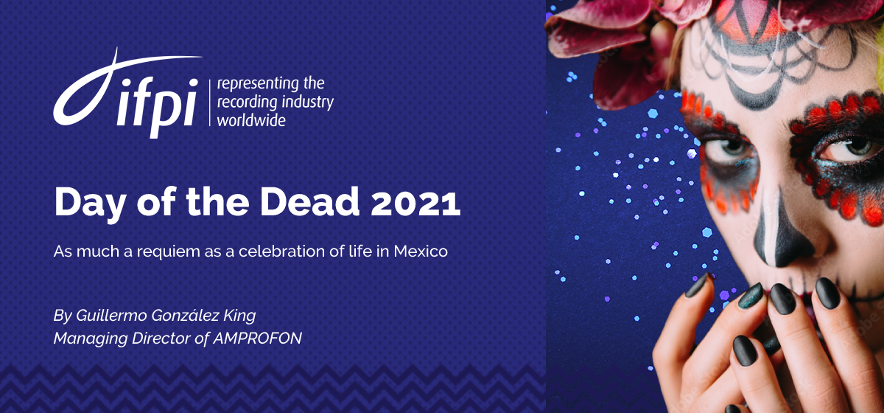
Dear all,
Celebrations for the colourful Mexican holiday Día de los Muertos (Day of the Dead) begin today, lasting until tomorrow.
Guillermo González King, Managing Director of our Mexican National Group AMPROFON, has written an incredibly informative and interesting account of the history of the holiday, with all of its rich meanings and traditions.
Guillermo has also kindly compiled a playlist of music related to Day of the Dead, which we encourage you to listen to!
As ever, we’d love to hear your feedback at diversity@ifpi.org.
The Diversity & Inclusion Committee

Cosmovision: “Especially in Literary Criticism or with reference to Mesoamerican peoples: a particular way of viewing the world or of understanding the universe.” - Oxford English Dictionary
In his 1950 essay The Labyrinth of Solitude Mexican Nobel Prize laureate Octavio Paz wrote: “The cult of life, if it’s truly profound and total, it is also a cult of death. Both are inseparable. A civilization that denies death ends up denying life”. This observation is fitting when attempting to explain how an ancestral Mesoamerican celebration of death, that predates the arrival of European settlers to the Americas and ancient Mexico, has become perhaps the most colorful, iconic, and aesthetically astounding tradition to transcend this country´s borders: Día de Muertos, or the Day of the Dead.
The Day of the Dead celebration in Mexico has a dichotomy of meanings. “Death” has the most morbid connotation of any word in any language, whereas “celebration” casts the opposite initial reaction. A celebration should convey a feeling of joy. How can happiness coexist with the catalyst of mourning? However, the Mexican Day of the Dead, which is actually a 48-hour collective exercise in remembrance, aspires to accomplish precisely that, oscillating between two opposing feelings that within a two-day time span can bring both elation and a vivid reminder of our existence.
Day of the Dead through history
How did this celebration come to be? (if in fact its origin can be traced back at all). The commonly agreed upon origin would be the legend of Mictlán.
Mesoamerican mythology describes Mictlán as “the eternal resting site of the dead”, the destination of the souls of those who suffered a natural death. For the original inhabitants of central Mexico, death was not an event as much as a pilgrimage. They perceived death as a process of disaggregation. The flesh remained in the realm of the living and would disintegrate over time, but the soul transcended, embarking in a four-year journey to reach Mictlán. The surviving relatives would lay to rest their loved ones along with some of their belongings in life. In addition, they provided items thought to be required in the pilgrimage to their final resting place, amongst them musical instruments made of clay, wood, reed, or bone. This treacherous mythological journey required the crossing of the Itzcuintlán river with the help of a drab colored Xólotl (dog). For these Mexican tribes, the rearing of Xólotls was of such significance that they believed that anyone who mistreated a Xólotl in life would never reach Mictlán, their soul condemned to roam the earth for eternity. Xoloitzcuintles, a bald, pale breed of endemic Mexican dogs, are still today a prized companion and iconic symbol of Mexican culture.

Photograph credit: Clemente Piña
The Judeo-Christian beliefs and traditions of the Spaniards that disembarked in Mexico brought a different concept of death: a more sudden and definite one rooted in a transcendental path to a final resting site for the soul. Catholic scripture and European traditions intertwined with local practices and beliefs. These slowly formed an amalgam of new world customs and traditions that began shaping some of the elements that, along with popular culture over the span of centuries, spawned the contemporary celebration of the Day of the Dead in Mexico.

Days of celebration
There are two defining days of reminiscence that encompass the celebration: every November 1st is devoted to the solemn Christian observance of “All Saints”, where canonical respect prevails. This is also, as part of Mexican lore, the day that the souls of departed children come to visit. On November 2nd, the faithful departed are commemorated. On this day, the souls of deceased adults and the elderly arrive to join their loved ones in the celebration. Both conventions, part of the yearly calendar of the catholic church, hold the same significance throughout many Latin American countries. But Mexicans have considerably strayed from the stately tradition and have turned it into a folkloric feast that was proclaimed a cultural heritage masterpiece by UNESCO on November 7th, 2003. The UNESCO committee stated that the celebration of the Day of the Dead “represented one of the most relevant renditions of the living heritage of Mexico and the world, as well as one of the most ancient and powerful cultural expressions amongst its indigenous groups”.
Day of the Dead symbols
Inquisitorial laws brought from the old world mixed with abstract superstitions that reigned in the new flourished in a rich iconography that has evolved over centuries and become part of the visual aesthetic of Mexico. To fully understand the Day of the Dead celebration, recognition of its most outstanding symbols is indispensable.

“La Catrina” The representation of death in embellished female form, product of the marriage of two cultures.
This portrayal of a skeletal European woman is perhaps the most recognized element of the day of the dead celebration in Mexico and abroad. Oddly, La Catrina did not resonate with the original inhabitants of central Mexico before the 16th century. For them, Mictlán was the realm of Mictlantecuhtli, the lord of death and ruler of the underworld. La Catrina's origin can be traced back to the late 1800s when polarizing social inequalities amongst Mexicans fueled a disdain for those members of society that eagerly embraced European traditions. This portrayal of death, as the equivalent of an 18th century European fashionista dressed in Victorian garb, was originally referred to as “La calavera garbancera” or the “garbanzo eating skeleton”, a direct reference to those that preferred garbanzo (a grain brought to Mexico by the Spaniards) over endemic legumes.
Cartoonist José Guadalupe Posadas (1852-1913) popularised the portrayal of this iconic female image of death, immortalized by Diego Rivera in his mural “Sueño de una tarde dominical en la Alameda Central” (1947), an idyllic depiction of a Sunday afternoon in then Mexico City´s central square, where the bourgeoisie gathered. As an homage, Diego Rivera included Posadas standing next to La Catrina, holding her left hand. Her right hand is being held by a young, childlike Diego Rivera. Immediately behind him stands Frida Khalo.
The cultural importance of the image of La Catrina in present day Mexico is such that during the Day of the Dead celebration, women dress like her and paint their faces to resemble a skeletal visage, a custom that has transcended the country´s borders and become a staple choice in masquerades throughout the world. Men do the same to portray the male counterpart depiction of death, known as “El Catrín”.
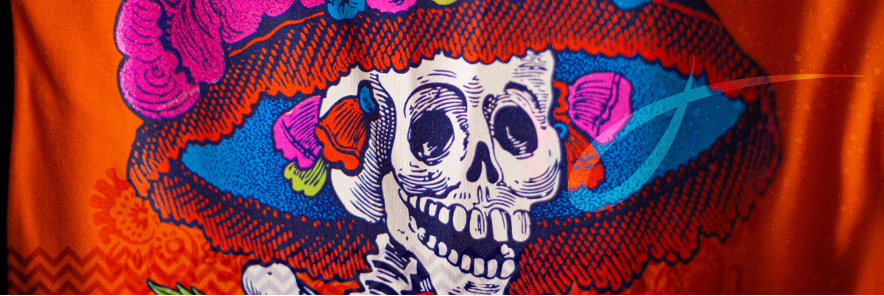
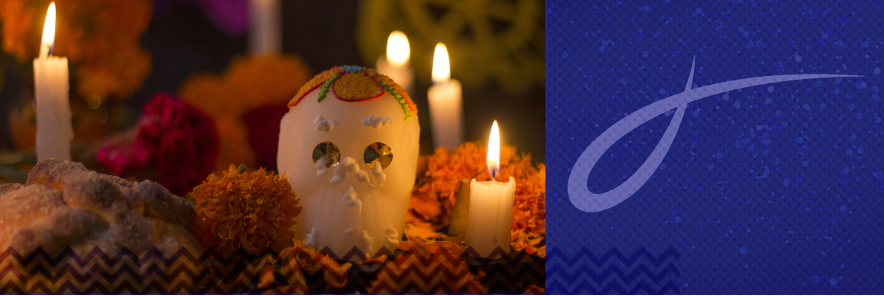
“Cempasúchil” Flower of twenty petals in Nahuatl.
The significance of this specific flower is rooted in another ancient legend. One that tells the story of two lovers, Xóchitl and Huitzilín. These two children would climb to the top of a mountain every morning to deposit an offering of flowers to Tonatiuh, the sun god, who would smile back at them. The lovers made an oath to be together eternally. As time passed, a war broke out. Huitzilín fought as a soldier and perished in battle. Xóchitl, devastated, climbed to the top of the mountain, and pledged to Tonatiuh to join her in eternity with her lover. The sun god, moved by her grief, casted one of his rays, and turned her into a flower. Soon after, a hummingbird (this word means Huitzil in Nahuatl), reached the flower and at the presence of the tiny bird, it blossomed in to twenty petals.
Cempasúchil is harvested in the autumn, close to the celebration of the day of the dead. In pre-Hispanic times, it was believed that this flower would illuminate the spirits of the dead with its color and scent resembling the sun.
“Huitzil” messengers and bearers of good wishes.
Hummingbirds were considered a sign of valor and equated with warrior spirits. Their metallic sheen represented an armor to the tribes that inhabited central Mexico. It was also believed that they could transport good wishes from deceased loved ones. Today, huitzils are still strongly associated with the Day of the Dead celebration. It is commonly believed that sighting a hummingbird is a sign of a loved one sending their regards.

Photograph credit: Clemente Piña
“Calaveritas de azúcar”
Skulls, a symbol of death, also appear in playful fashion in the celebration of the Mexican day of the dead in the form of “calaveras de azúcar”. These edible candy skulls are made mostly of “alfeñique”, a mixture of sugar, egg whites, lemon juice and corn starch, although chocolate is sometimes also employed in the craft of skulls. Each skull commonly has the name of a deceased loved one inscribed on its forehead. The skull is then placed in a funeral shrine or “Altar de Muertos”, as a form of respect and remembrance.

“Altar de muertos” A shrine built out of craft and memory.
Altars of the dead are commonly placed in homes during the Day of the Dead celebrations. In towns and city plazas they can often become magnificent edifications. The altars gather elements of Christian and Mesoamerican tradition and serve a crucial purpose in honoring the dearly departed.
Year after year, the “altar de muertos” becomes an ephemeral offering that binds remembrance. Its tangible elements include, amongst other things, a photograph of the deceased relative in life, along with a personal belonging if available - perhaps a pair of spectacles, a favorite hat or tie, a comb, a handkerchief, or any other small object. Some of the dead person’s preferred foods should also be included, though nonperishables tend to be the norm nowadays, such as crystalized fruit like creole squash, yam, sugar cane, or biznaga, a traditional edible cactus. Beverages, both non-alcoholic as well as some spirits, accompany the feast. “Pulque”, an ancestral fermented drink made from the agave plant and still popular in Mexico, was the preferred choice for indigenous tribes in the past.
Flowers are also imperative in any “altar de muertos”. The type of flowers used strongly depends on availability in different regions: in central and southern Mexico, the endemic ancestral flower known as “cempasúchil” (calendula or Mexican marigold in other parts of the world) adorns not only the altar of the dead, but any promenade that the visiting spirit of a loved one may stroll. The “altar de muertos” is framed in a cempasúchil arch which represents the entryway to the world of the living. Petals form a pathway from the altar to different halls, windows, and the main entryways to homes and cemeteries so the souls of the dearly departed will not stray.
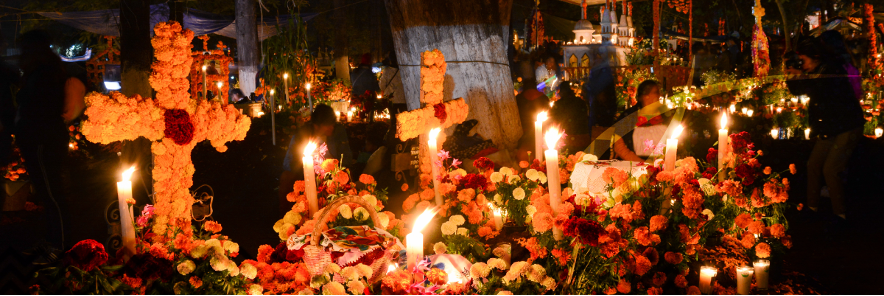
Over time, other items have made their way to the “Altar de Muertos”: candles, their flame representing faith and hope; crosses, rosaries and images of catholic saints as intermediaries in the eternal salvation of the souls; incense as an instrument of purification; salt, a preserving agent used by Mesoamerican peoples in the embalming process; elaborate accordion-like colored paper decorations known as “papel picado” contribute a festive element in any altar.
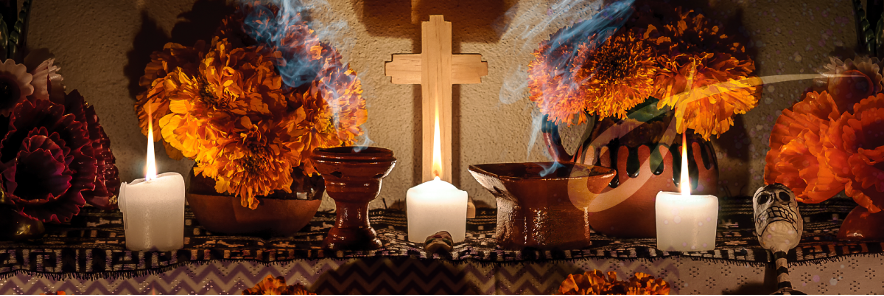
But perhaps the most important and meaningful element required – in both the assembly of any “altar de muertos” and the ethos of the celebration of the Day of the Dead overall – is recollection of the dead and the implied promise to perpetuate this act of remembrance. Afterlife in Mictlán was thought to be possible as long as the memory of the dead was preserved in the thoughts and respects of their living loved ones. The celebration of the Day of the Dead then, becomes a practice in harnessing memories. Some of these will evoke tears but most should conjure happiness and a lust for life.
Listen to a playlist of songs related to Day of the Dead on Apple Music here.
Last changed: Nov 01 2021 at 1:21 PM
Regresar








